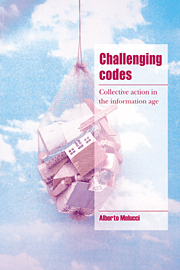Book contents
- Frontmatter
- Contents
- Preface and acknowledgements
- Introduction
- Part I Theory of collective action
- Part II Contemporary collective action
- Part III The field of collective action
- Part IV Acting collectively
- 15 Mobilization and political participation
- 16 The organization of movements
- 17 Leadership in social movements
- 18 Collective action and discourse
- 19 Forms of action
- 20 Research on collective action
- References
- Index
15 - Mobilization and political participation
Published online by Cambridge University Press: 23 November 2009
- Frontmatter
- Contents
- Preface and acknowledgements
- Introduction
- Part I Theory of collective action
- Part II Contemporary collective action
- Part III The field of collective action
- Part IV Acting collectively
- 15 Mobilization and political participation
- 16 The organization of movements
- 17 Leadership in social movements
- 18 Collective action and discourse
- 19 Forms of action
- 20 Research on collective action
- References
- Index
Summary
Collective action as a social phenomenon
The preceding chapters on the internal functioning of the political system repeatedly presented the need for an analysis of interests and forms of action which are formed before and beyond the boundaries and the rules of the political game. Social movements and collective action are the constant reminder of the limits of politics; they remind society of the fact that social processes create demands for politics while occupying areas at the same time prior to and beyond politics. Collective action is fed by needs that originate in the social fabric of everyday life and are not comprehended by the political system or are excluded by its filters; but its emergence is no less encouraged by expectations and demands that are bypassed by the decision-making process – that is, by the negative or insufficient outcome of the political game.
In this chapter and the ones that follow it in part IV, specific attention will be drawn to the internal processes by which a ‘movement’ is formed and becomes a visible actor, sometimes as an organization participating, directly or indirectly, in the political system. Theoretical thought on the social dimension of social movements is much less developed than that regarding their role as political actors. In recent years, multiplication of forms of collective action has dramatically underlined this shortage of theory, making a new critical assessment necessary and calling for new analytical instruments.
- Type
- Chapter
- Information
- Challenging CodesCollective Action in the Information Age, pp. 287 - 312Publisher: Cambridge University PressPrint publication year: 1996

